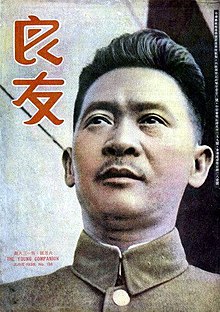Zhang Fakui
Zhang Fakui | |
|---|---|
張發奎 | |
 Zhang Fakui on the cover of The Young Companion, June 1938 | |
| 3rd Commander-in-Chief of the Republic of China Army | |
| In office 9 February 1949 – 26 June 1949 | |
| President | Li Zongren |
| Preceded by | Yu Hanmou |
| Succeeded by | Gu Zhutong |
| Personal details | |
| Born | 2 September 1896 Encirclement Campaigns, Second Sino-Japanese War, Chinese Civil War |
| Zhang Fakui | |
|---|---|
Hanyu Pinyin | Zhāng Fākuí |
| Wade–Giles | Chang Fa-kuei |
| IPA | [ʈʂáŋ fá.kʰwěɪ] |
| Yue: Cantonese | |
| Jyutping | Zoeng1 Faat3-kwai1 |
Zhang Fakui
Life
Early life
Zhang Fakui was born in 1896 in
World War II
During the
There was a unique feature for the telephone conversations with Chiang Kai-shek, because Zhang was a Hakka, and the two had difficulties in understanding each other: instead of simply hanging up the phone after giving out orders like he did to everyone else, during the conversation with Zhang, Chiang always asked Zhang if he understood what he had just said, and Chiang always waited until after Zhang gave an affirmative answer.
During the struggle against the Japanese, Zhang was among the first Army Corps commanders to ask the Chinese military to change its code because he discovered that Japanese could easily decode the Chinese code at the early stage of the war. After the war he was made to march into Hong Kong accept the surrender of the Japanese troops and stayed until the restoration of the British. He was awarded
Zhang was nicknamed Zhang Fei, after the historical Three Kingdoms figure.[1]
Chinese Civil War
After the
Vietnamese Revolution
Zhang Fakui was instrumental in the Kuomintang support of Vietnamese revolutionary organizations and parties against the
Zhang worked with Nguyen Hai Than, a VNQDD member, against French Imperialists and Communists in Indochina.[7] General Chang Fa-kuei planned to lead a Chinese army invasion of Tonkin in Indo China to Free Vietnam from French control, and to get Chiang Kai-shek's support.[8]
Retirement
In June 1949, Zhang resigned and moved to British Hong Kong. He later became the President of the Tsung Tsin Association, the umbrella body for Hakka people in Hong Kong. He had built schools back in his native village. He was the organizer of the First World Hakka Congress in Hong Kong and died there in 1980. He stayed neutral leaning neither to the Communists nearby or his previous Nationalist Government. Despite numerous pleas from both Taiwan and the mainland, he never visited either place. When he died, his old subordinate communist Hakka leader Ye Jianying, by now a Marshal in the PLA, and contemporary Taiwan's leader Chiang Ching-kuo sent their condolence letters to express their sorrow.
Military career
- 1926 General Officer Commanding IV Corps
- 1926 - 1927 General Officer Commanding 12th Division
- 1927 Retired
- 1936 - 1937 Commander in Chief Zhejiang-Fujian-Anhui-Jiangxi Border Area
- 1937 - 1938 Commander in Chief 8th Army Group
- 1937 Commander in Chief Right Wing 3rd War Area
- 1938 Commander in Chief 2nd Army Corps, Battle of Wuhan
- 1939 - 1944 Commander in Chief 4th War Area
- 1944 Commander in Chief Guilin War Zone
- 1944 - 1945 Commander in Chief 2nd Front Army
References
Citations
- ^ Association for Asian Studies, Far Eastern Association, JSTOR (Organization) (1944). The Journal of Asian studies, Volumes 3-4. Association for Asian Studies. p. 163. Retrieved 4 June 2011.
{{cite book}}: CS1 maint: multiple names: authors list (link) - ISBN 0-520-04156-9. Retrieved 30 November 2010.
- ISBN 0-231-06909-X. Retrieved 30 November 2010.
- ISBN 9780894532870. Retrieved 30 November 2010.
- ISBN 0-313-31170-6. Retrieved 30 November 2010.
- ISBN 0-8014-0951-9. Retrieved 30 November 2010.
- ISBN 9780020735908.
- ^ Fitzsimmons, James (1975), Lugano Review, Vol. II, Nos. 4-6, J. Fitzsimmons, p. 6.
Bibliography
- Hsu Long-hsuen and Chang Ming-kai, History of The Sino-Japanese War (1937–1945) 2nd Ed., 1971. Translated by Wen Ha-hsiung, Chung Wu Publishing; 33, 140th Lane, Tung-hwa Street, Republic of China.
